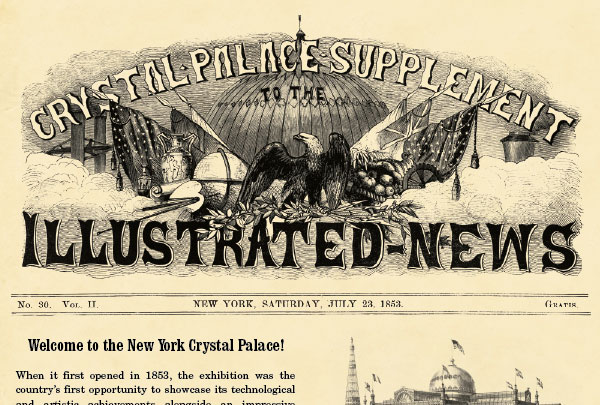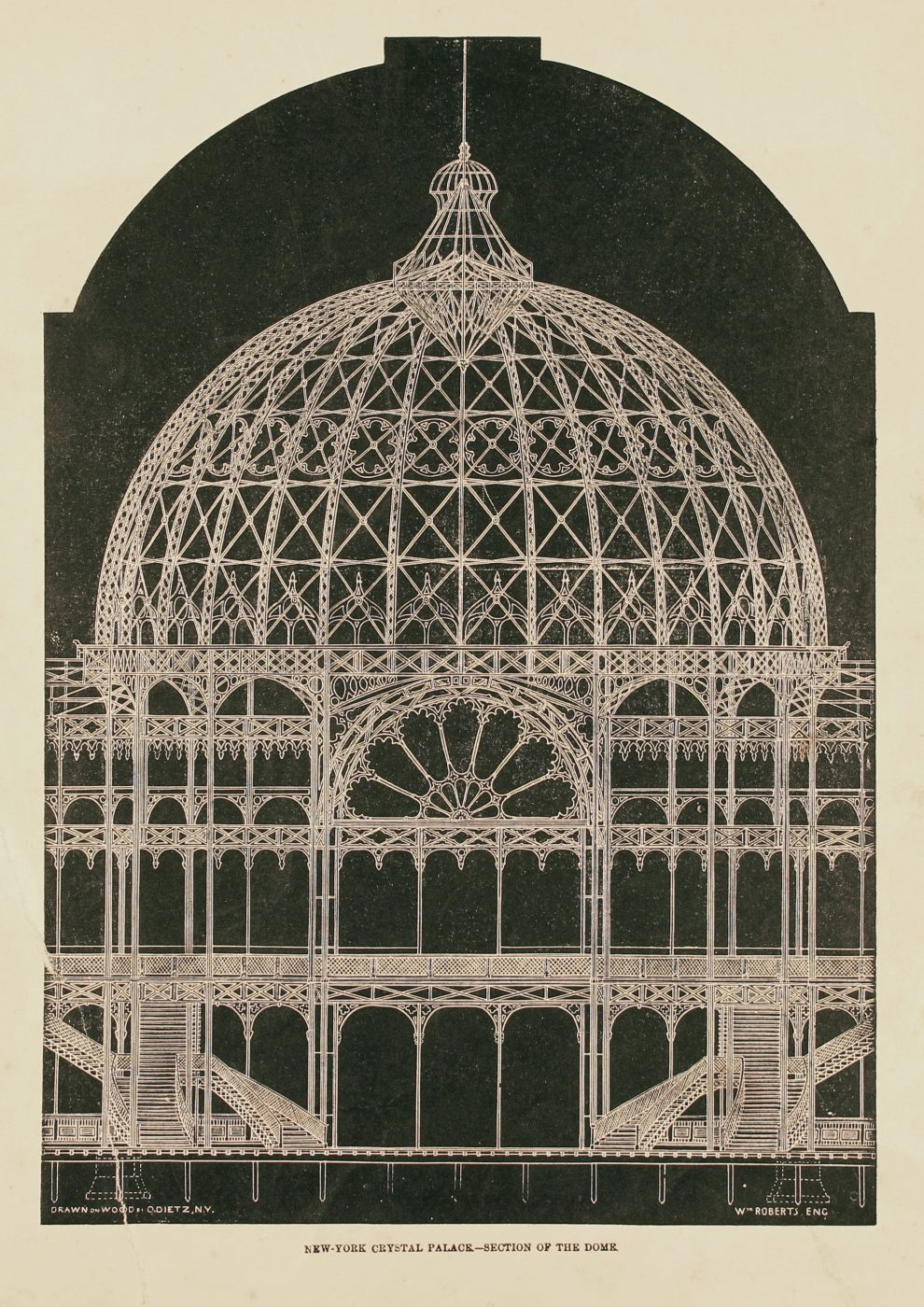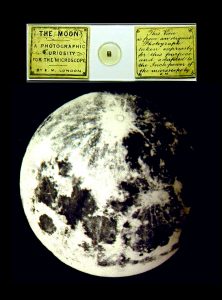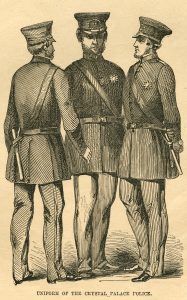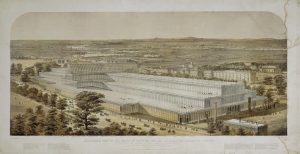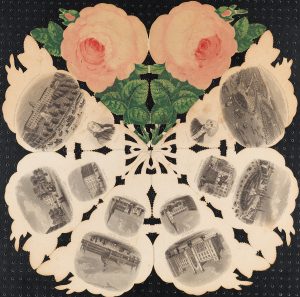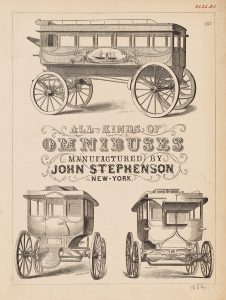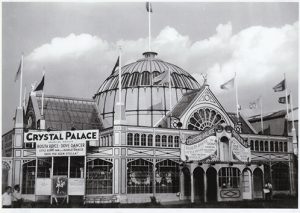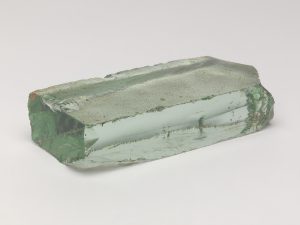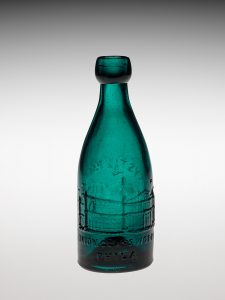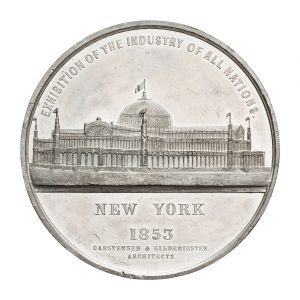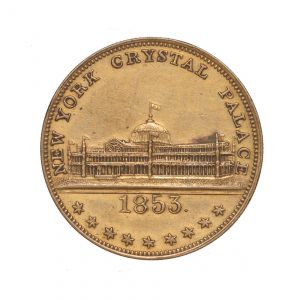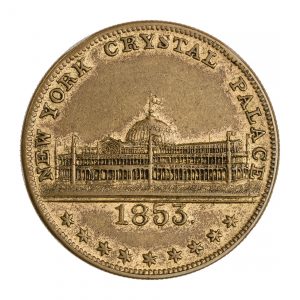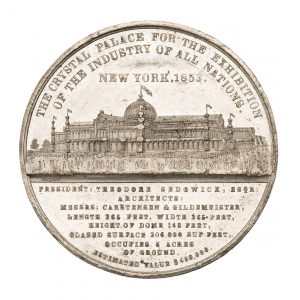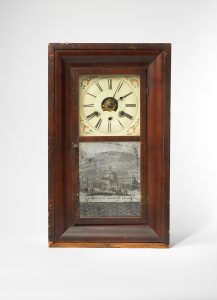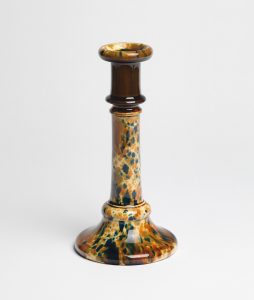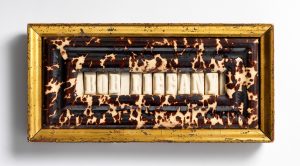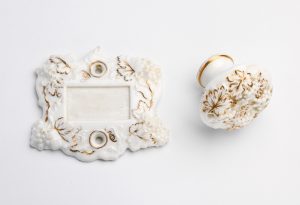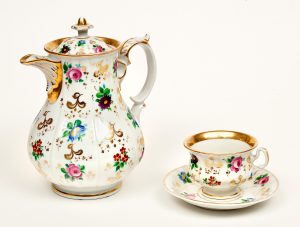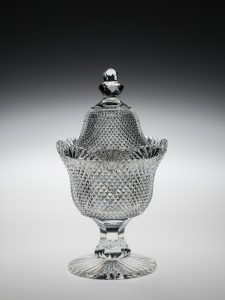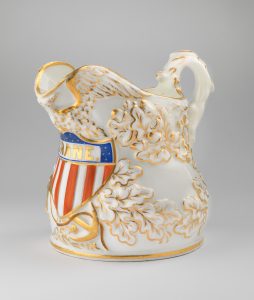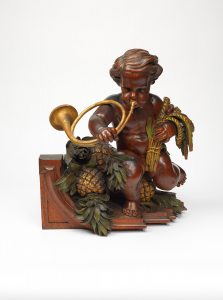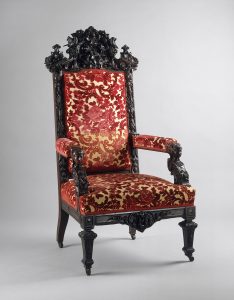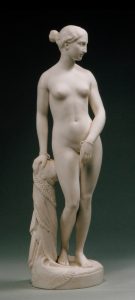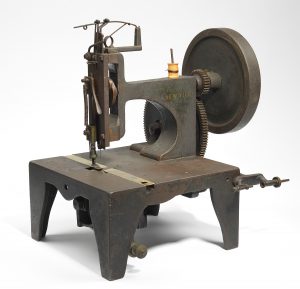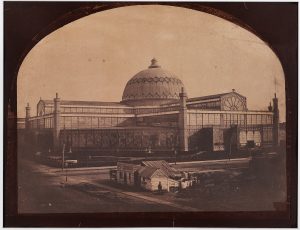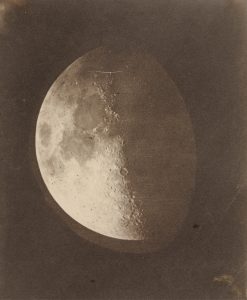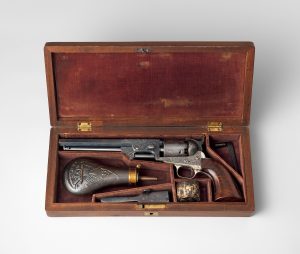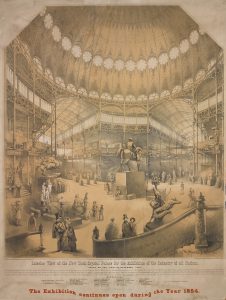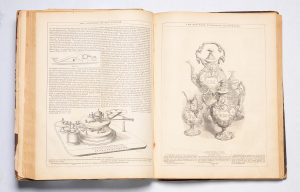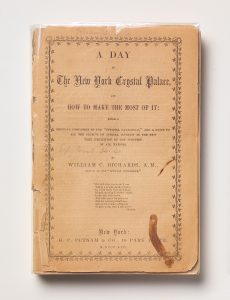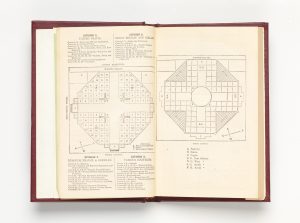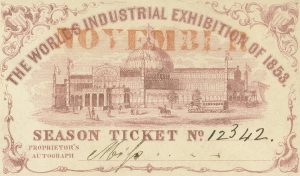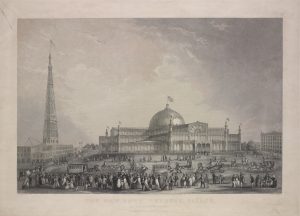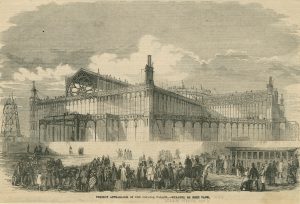Primary Sources: Books
Carstensen, Georg and Charles Gildemeister. New York Crystal Palace: Illustrated Description of the Building. New York: Riker, Thorne & Co. 1854.
Carvalho, Solomon Nunes. Incidents of Travel and Adventure in the Far West: With Col. Frémont’s Last Expedition Across the Rocky Mountains: Including Three Months’ Residence in Utah, and a Perilous Trip Across the Great American Desert to the Pacific. New York: Derby and Jackson, 1860.
Foster, George G. Fifteen Minutes Around New York. New York: DeWitt & Davenport, 1854.
Foster, George G. New York by Gas Light: With Here and There a Streak of Sunshine. New York: Dewitt & Davenport, 1850.
Foster, George G. New York in Slices. New York: W.F. Burges, 1850.
Greeley, Horace. Art and Industry as Represented in the Exhibition at the Crystal Palace in New York 1853. New York: Redfield, 1853.
How to See the Crystal Palace: Being a Concise Guide to the Principal Objects in the Exhibition. New York: G.P. Putnam & Co., 1854.
Mathews, Cornelius. Pen-and-Ink Panorama of New-York City. New York: Johns S. Taylor, 1853.
Matsell, George Washington. Vocabulum; Or, The Rogue’s Lexicon. Comp. from the Most Authentic Sources. New York: G. W. Matsell, 1859.
Official Catalogue of the New-York Exhibition of the Industry of all Nations, 1853. New York: George P. Putnam & Co., 1853.
Richards, William C. A Day in the New York Crystal Palace and How to Make the Most of It: Being a Popular Companion to the “Official Catalogue”, and a Guide to All the Objects of Special Interest in the New York Exhibition of the Industry of All Nations. New York: G.P. Putnam, 1853.
Rodgers, Charles T. American Superiority at the World’s Fair. Philadelphia: John J. Hawkins, 1852.
Saunders, Frederick. New York in a Nut-Shell. New York: T. W. Strong, 1853.
Silliman Jr., Benjamin and C.R. Goodrich. The World of Science, Art, and Industry Illustrated from Examples in the New-York Exhibition, 1853-54. New York: G.P. Putnam, 1854.
The Association for the Exhibition of the Industry of All Nations. The Official Awards of Juries. New York, W.C. Bryant & Co., 1853.
Primary Sources: Periodicals
American Quarterly
Brooklyn Daily Times
Gleason’s Pictorial Drawing-Room Companion
Harper’s New Monthly Magazine
Illustrated News
Maine Farmer
New York Daily News
New York Daily Times
New York Herald
Prairie Farmer
Putnam’s Monthly
The Albion; A Journal of News, Politics and Literature
The Daily Comet
The Illustrated Magazine of Art
The New York Times
Weekly Vincennes Gazette
Secondary Sources
Auerbach, Jeffrey. The Great Exhibition of 1851: A Nation on Display. New Haven: Yale University Press, 1999.
Banham, Joanna, Sally MacDonald and Julia Porter. Victorian Interior Design. New York: Crescent Books, 1991.
Bartlett, Randall. The Crisis of America’s Cities. Armonk, N.Y.: M.E. Sharpe, 1998.
Bellion, Wendy. Citizen Spectator: Art, Illusion, and Visual Perception In Early National America. Chapel Hill: University of North Carolina Press, 2011.
Bennett, Tony. “The Exhibitionary Complex.” In Culture/Power/History: A Reader in Contemporary Social Theory, by Nicholas B. Dirks. Princeton, NJ: Princeton University Press, 1994.
Bergmann, Hans. God in the Street: New York Writing from the Penny Press to Melville. Philadelphia: Temple University Press, 1995.
Blumin, Stuart M. “Explaining The New Metropolis: Perception, Deception, Depiction.” Journal of Urban History, 11 (1984): 9–38.
Blumin, Stuart M. The Emergence of the Middle Class: Social Experience in the American City, 1760-1900. Cambridge: Cambridge University Press, 1989.
Bredekamp, Horst, Vera Dünkel, and Birgit Schneider. The Technical Image: A History of Styles in Scientific Imagery. Chicago, IL: University of Chicago Press, 2015.
Breidbach, Olaf. “Representation of the Microcosm: The Claim for Objectivity in 19th-Century Scientific Microphotography.” Journal of the History of Biology 35, no. 2 (2002): 221–50.
Brown, Henry Collins. Valentine’s Manual of Old New York. Hastings-on-Hudson, N.Y.: Valentine’s Manual, 1927.
Burrows, Edwin G. Gotham: A History of New York City to 1898. New York: Oxford University Press, 1999.
Burrows, Edwin, G. “Seeing New York.” In Gotham: A History of New York City to 1898. New York: Oxford University Press, 1999.
Calè, Luisa, and Patrizia Di Bello. Illustrations, Optics, and Objects in Nineteenth-Century Literary and Visual Cultures. New York: Palgrave Macmillan, 2010.
Calefato, Patrizia. “Signs of Order, Signs of Disorder: The Other Uniforms.” In Uniform: Order and Disorder, edited by Francesco Bonami, Maria Luisa Frisa, and Stefano Tonchi, 195–204. Milan: Charta, 2000.
Clinkscale, Marth Novak. Makers of the Piano, Vol. 2, 1820–1860. Oxford: Oxford University Press, 1999.
Costello, Augustine E. Our Police Protectors: History of the New York Police from the Earliest Period to the Present Time. A.E. Costello, 1885.
Crary, Jonathan. Techniques of the Observer: On Vision and Modernity in the Nineteenth Century. Cambridge, Mass.: MIT Press, 1990.
Delgado, James P. Gold Rush Port: The Maritime Archaeology of San Francisco’s Waterfront. Berkeley: University of California Press, 2009.
Dodson, Howard. The Black New Yorkers: The Schomburg illustrated chronology. New York: John Wiley, c2000.
Dolgy, Alfred. Pianos and Their Makers. California: Covina Publishing Company, 1911.
Eco, Umberto. “A Theory of Expositions.” In Travels in Hyperreality. Boston, MA: Houghton Mifflin Harcourt, 2014.
Gelernter, David Hillel. 1939, the Lost World of the Fair. New York: Free Press, 1995.
Giedion, Sigfried. Space, Time and Architecture. Cambridge, MA: Harvard University Press, 1982.
Greco, Lorenzo. “Social Identity, Military Identity.” In Uniform: Order and Disorder, edited by Francesco Bonami, Maria Luisa Frisa, and Stefano Tonchi, 145–52. Milan: Charta, 2000.
Greenhalgh, Paul. “Origins and Conceptual Development.” In Ephemeral Vistas: The Expositions Universelles, Great Exhibitions, and World’s Fairs, 1851-1939. Manchester: Manchester University Press, 1988.
Grier, Katherine. Culture and Comfort: parlor making and middle-class identity, 1850-1930. Washington, DC: Smithsonian, 1997.
Gross, Linda P., and Theresa R. Snyder. Philadelphia’s 1876 Centennial Exhibition. Charleston, SC: Arcadia, 2005.
Henkin, David. City Reading: Written Words and Public Spaces in Antebellum New York. New York: Columbia University Press, 1998.
Hollengreen, Laura, Celia Pearce, Rebecca Rouse, Bobby Schweizer, et al. Meet Me at the Fair: A World’s Fair Reader. Pittsburgh, PA: Carnegie Mellon University ETC Press, 2014
Hyman, Linda. Crystal Palace, 42 Street, 1853-54: [exhibition] City University Graduate Center Mall. New York: City University of New York, 1974.
Keller, Corey. Brought to Light: Photography and the Invisible, 1840–1900. San Francisco: San Francisco Museum of Modern Art, 2008.
Kelly, Raymond W. The History of New York City Police Department. New York: New York City Police Department, 1993.
Leja, Michael. “Sculpture of a Mass Market,” in John Rogers: American Stories, edited by Kimberly Orcutt. New York: New-York Historical Society, 2010.
Leskosky, Richard J. “Phenakiscope: 19th–Century Science Turned to Animation.” Film History 5, no. 2 (1993): 176–89.
Lobel, Cindy R. Urban Appetites: Food and Culture in Nineteenth-Century New York. Chicago: University of Chicago Press, 2014
Meyer, Jonathan. “New York 1853.” In Great Exhibitions: London, New York, Paris, Philadelphia, 1851–1900. Woodbridge, Suffolk: Antique Collectors Club, 2006.
Mortz, Marilyn Ferris. Making the American Home: Middle-Class Women and Domestic Material Culture, 1840-1940. Ohio: Bowling Green State University Popular Press, 1988.
Peterson, Carla L. Black Gotham: A Family History of African Americans in Nineteenth Century New York City. New Haven and London: Yale University Press, 2011.
Phillips, Clare. Bejewelled by Tiffany, 1837-1987. Connecticut: Yale University Press, 2006.
Post, Robert. “Reflections of American Science and Technology at the New York Crystal Palace Exhibition of 1853.” American Studies 17 (December 1963): 337–356.
Richards, Thomas. “The Great Exhibition of Things” In The Commodity Culture of Victorian England: Advertising and Spectacle, 1851–1914. Palo Alto, CA: Stanford University Press, 1990.
Robinson, Lauren. “John Stephenson Company Cars.” MCNY Blog: New York Stories. http://wp.me/p1kGOJ-22Y, Accessed December 1, 2015.
Ruff, Joshua, and Michael Cronin. Images of America: New York City Police. Charleston, SC: Arcadia, 2012.
Rydell, Robert W., John E. Findling, and Kimberly D. Pelle. Fair America: World’s Fairs in the United States. Washington, DC: Smithsonian Institution Press, 2000.
Schickore, Jutta. The Microscope and the Eye: A History of Reflections, 1740–1870. Chicago: University of Chicago Press, 2007.
Schivelbusch, Wolfgang. Disenchanted Night: The Industrialization of Light In the Nineteenth Century. 1st paperback printing Berkeley: University of California Press, 1995.
Schmidgen, Henning. “Pictures, Preparations, and Living Processes: The Production of Immediate Visual Perception (anschauung) in Late-19th-century Physiology.” Journal of the History of Biology 37 (2004): 477–513.
Scobey, David. Empire City: The Making and Meaning of the New York City Landscape. Philadelphia: Temple University Press, 2002.
Silverman, Robert J. “The Stereoscope and Photographic Depiction in the 19th Century.” Technology and Culture 34, no. 4 (1993): 729–56.
Steen, Ivan. “America’s First World’s Fair: The Exhibition of the Industry of All Nations at New York’s Crystal Palace, 1853-1854.” New-York Historical Society Quarterly 47 (July 1963): 257–2 87.
Tamila, Robert D. “World’s Fairs and the Department Store 1800s to 1930s.” Charm (2007).
Upton, Dell. “Inventing the Metropolis: Civilization and Urbanity in Antebellum New York.” In Art in the Empire City New York, 1825-1861, ed. by Catherine Voorsanger, 3–46. New Haven: Yale University Press, 2000.
Upton, Dell. Another City: Urban Life and Urban Spaces in the New American Republic. New Haven: Yale University Press, 2008.
Van Dulken, Stephen. Inventing the 19th Century: 100 Inventions That Shaped the Victorian Age from Aspirin to the Zeppelin. New York: New York University Press, 2006.
Voorsanger, Catherine Hoover, and John K. Howat, eds. Art and the Empire City: New York, 1825–1861. Exhibition catalogue. New Haven and New York: Yale University Press and The Metropolitan Museum of Art, 2000.
Walling, George Washington. Recollections of a New York Chief of Police. New York: Caxton Book Concern, 1887.
Wilcox, Cadmus Marcellus. History of the Mexican War. Church News Publishing Company, 1892.
Woloson, Wendy A. Refined Tastes: Sugar, Confectionery, and Consumers in Nineteenth-Century America. Baltimore: John Hopkins University Press, 2002.
Wurts, Richard, and Stanley Appelbaum. The New York World’s Fair, 1939/1940 in 155 Photographs. New York: Dover Publications, 1977.


